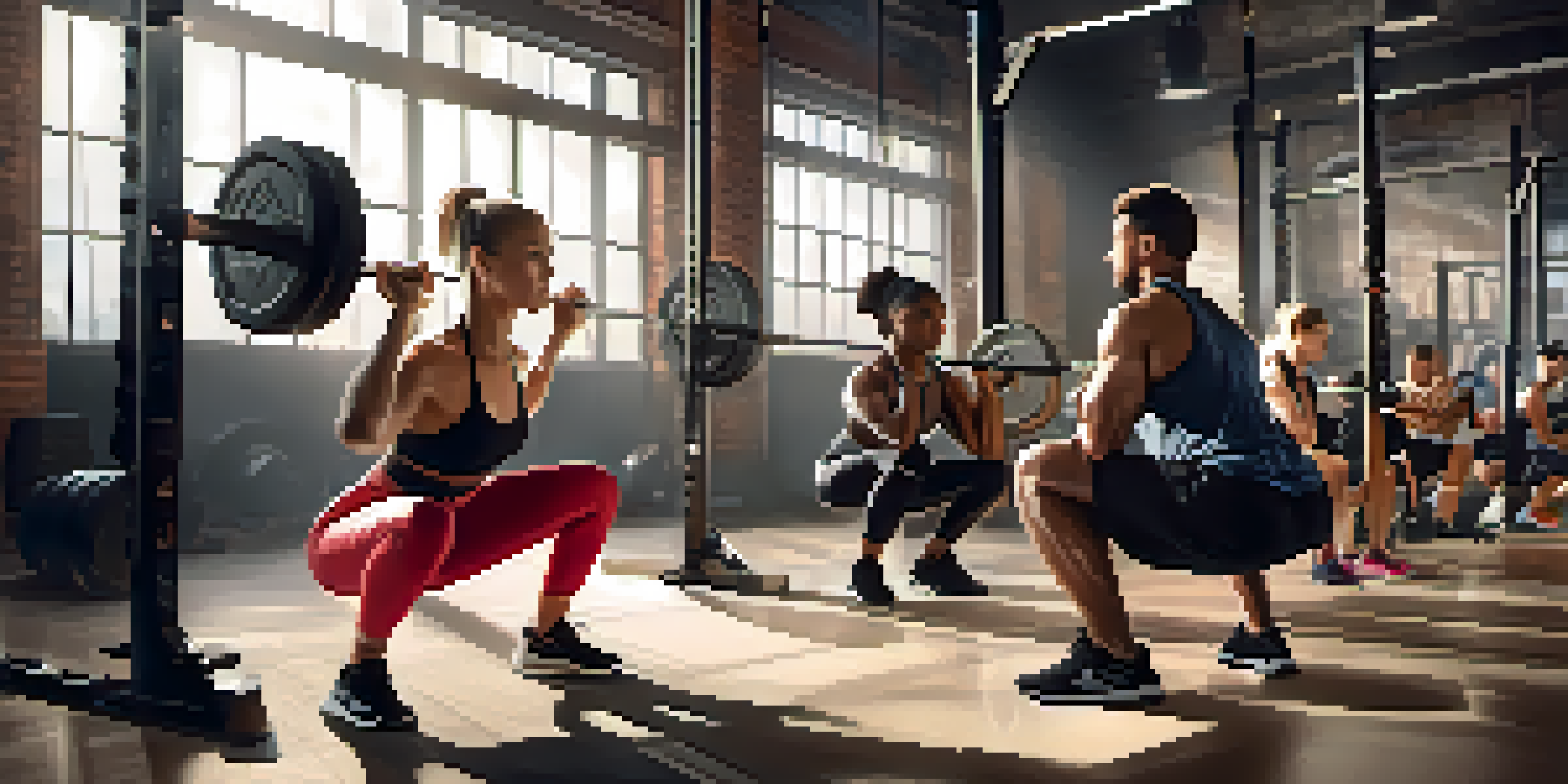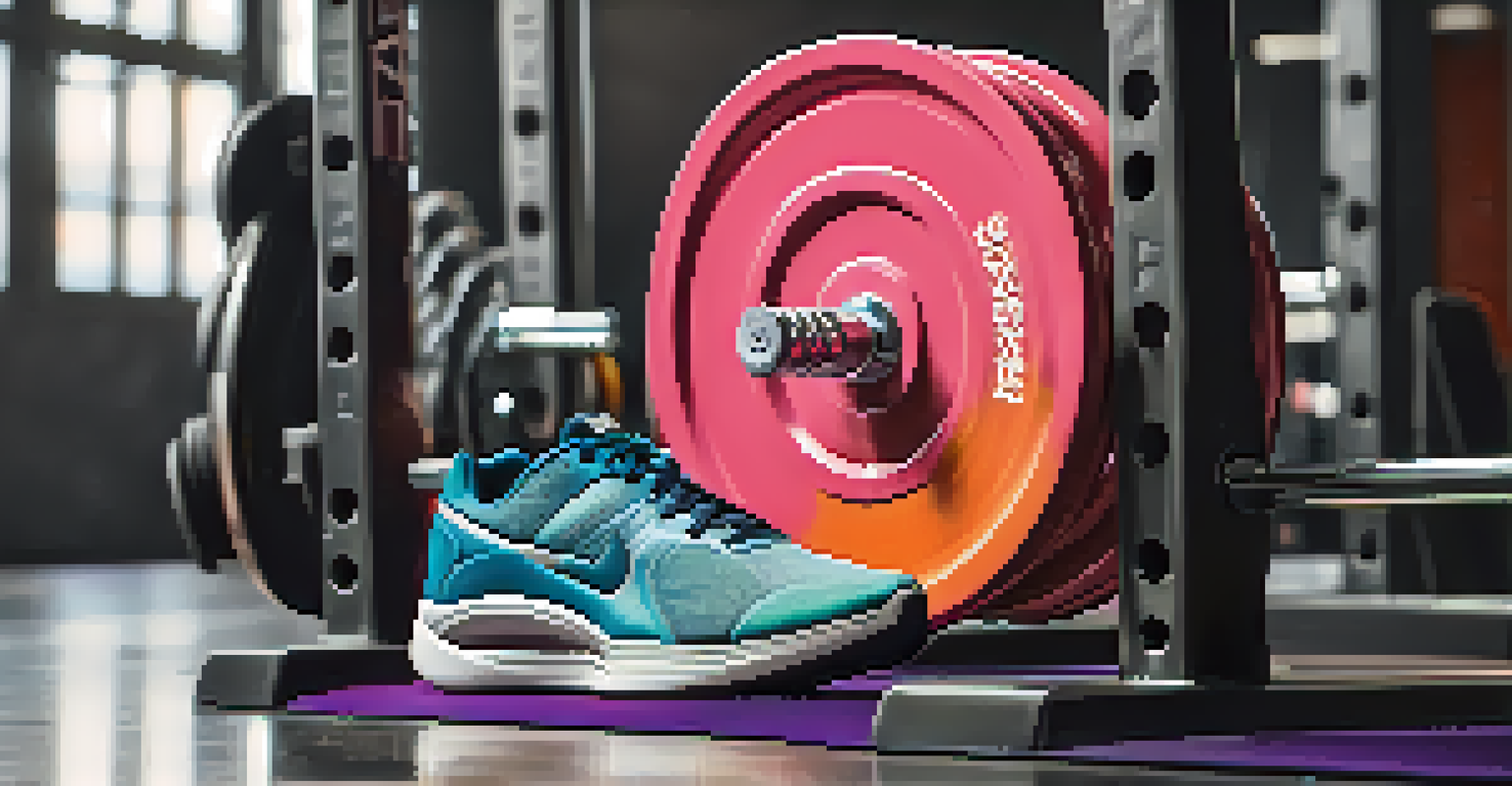The Role of Squats in Enhancing Sports Performance

Understanding the Basics of Squats and Their Benefits
Squats are a fundamental exercise that target multiple muscle groups, primarily the quadriceps, hamstrings, and glutes. They help athletes develop overall strength, which is crucial for almost every sport. By incorporating squats into a training regimen, athletes can improve their power output and endurance, leading to better performance on the field or court.
Strength does not come from physical capacity. It comes from an indomitable will.
Moreover, squats are a functional movement that mimics many athletic activities, such as jumping, sprinting, and changing direction. This makes them particularly effective in enhancing the specific skills needed in various sports. When athletes perform squats regularly, they build a strong foundation that translates to improved agility and coordination.
Additionally, the benefits of squats extend beyond just physical strength. They can also promote better posture and stability, which are essential for preventing injuries. With proper form and technique, athletes can ensure they are maximizing these benefits while minimizing the risk of strain.
How Squats Improve Lower Body Strength for Athletes
Lower body strength is a critical factor in nearly every sport, from running to basketball. Squats effectively target the muscles in the legs, helping athletes generate more power during explosive movements. This increased strength allows athletes to sprint faster, jump higher, and change directions with greater ease.

In addition to building strength, squats also enhance muscle endurance, which is vital for sustaining performance throughout a game or event. When athletes have strong, enduring leg muscles, they can maintain their speed and agility even as fatigue sets in. This can be the difference between winning and losing in a competitive setting.
Squats Build Overall Athletic Strength
Incorporating squats into training enhances lower body strength, core stability, and explosive power, crucial for athletic performance.
Furthermore, incorporating various squat variations, such as front squats or single-leg squats, can further enhance lower body strength. These variations target different muscle groups and can help address any imbalances, ensuring a well-rounded lower body workout.
The Role of Squats in Enhancing Core Stability
Core stability is essential for athletes, as it supports nearly all movements in sports. When performing squats, the core must engage to maintain proper form and balance. This engagement strengthens the abdominal and lower back muscles, contributing to overall core stability, which is crucial for performance.
The only way to prove you are a good sport is to lose.
A strong core helps athletes transfer power effectively from their lower to upper body, improving their overall athleticism. Whether it's throwing a ball, swinging a racket, or making quick lateral movements, a stable core allows for better control and coordination. This can lead to improved accuracy and efficiency in an athlete's performance.
Additionally, core stability gained from squats can help prevent injuries. A well-developed core supports the spine and pelvis, reducing the risk of strains and sprains during intense activities. Thus, squats not only build strength but also play a vital role in injury prevention.
Squats and Their Impact on Explosive Power
Explosive power is a key component in many sports, and squats can significantly enhance this attribute. By performing squats, athletes train their muscles to exert maximum force in a short amount of time. This is particularly beneficial for sports that require quick bursts of speed and agility, such as football or track and field.
Incorporating explosive squat variations, such as jump squats or plyometric squats, can further enhance an athlete's power output. These exercises challenge the muscles to generate force rapidly, conditioning them for the demands of high-intensity sports. When athletes can explode off the ground or change direction swiftly, they gain a competitive edge.
Injury Prevention Through Squats
Regular squatting strengthens muscles and improves flexibility, reducing the risk of common sports injuries.
Moreover, the power developed through squats translates not just to athletic performance but also to everyday activities. Whether it's lifting heavy objects or navigating obstacles, having explosive power can make daily tasks easier and safer.
Squats as a Foundation for Injury Prevention
Injuries can be a significant setback for any athlete, making injury prevention a top priority. Squats contribute to injury prevention by strengthening the muscles, ligaments, and tendons around joints, particularly the knees and hips. When these areas are strong, they are better equipped to handle the stresses of athletic activity.
Additionally, squats improve flexibility and range of motion in the hips, knees, and ankles. This flexibility is essential for maintaining proper movement patterns and reducing the risk of injuries caused by strain or overexertion. Athletes who incorporate squats into their training are less likely to experience common injuries associated with their sports.
Furthermore, focusing on proper squat form helps athletes develop body awareness and control. This awareness can translate to better movement patterns in their sport, reducing the likelihood of awkward movements that lead to injuries. In essence, squats are not just about building strength; they are a proactive measure for long-term athletic health.
Integrating Squats into Your Training Routine
To reap the benefits of squats, athletes should aim to integrate them into their training routines effectively. Starting with bodyweight squats can help beginners master proper form before progressing to weighted variations. This gradual approach ensures that athletes build strength safely and effectively.
It's also important to vary squat types to target different muscle groups and prevent plateaus in strength gains. Incorporating front squats, sumo squats, and goblet squats can keep workouts fresh and engaging. Athletes should also consider their specific sport's demands when deciding which squat variations to prioritize.
Consistency is Key for Benefits
To fully reap the benefits of squats, athletes should include them in their routines consistently, at least two to three times a week.
Finally, consistency is key. Athletes should aim to include squats in their training at least two to three times per week. By committing to regular squat training, athletes can enhance their performance and enjoy the many benefits this exercise has to offer.
Conclusion: The Transformative Power of Squats
In conclusion, squats are more than just a simple exercise; they are a powerful tool for enhancing sports performance. From building lower body strength and core stability to improving explosive power and preventing injuries, squats play a pivotal role in an athlete's training regimen. Their versatility allows athletes of all levels to benefit, regardless of their sport.
Moreover, the integration of squats into a training routine fosters a strong foundation that can lead to improved overall athleticism. As athletes become stronger and more stable, they can push their limits and achieve new personal records. This transformative power of squats is what makes them a staple in any athlete's training arsenal.

Ultimately, embracing squats as a cornerstone of fitness can lead to lasting improvements in performance, health, and confidence. Whether you're a seasoned athlete or just starting your fitness journey, squats are an exercise worth prioritizing.